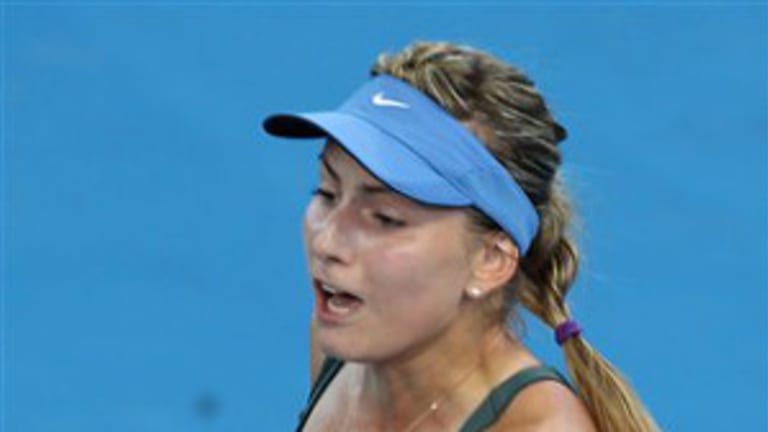NEW YORK—It was reckoning time, that point in some matches when two players simultaneously sense that a potentially decisive point beckons, that the match has reached some sort of crossroads. They can feel it in their bones.
Shahar Peer, once No. 11 in the world but currently the top seed in the U.S. Open qualifying tournament, was in trouble today out on Court 11. She had lost the first set to Ksenia Pervak, no slouch herself, 6-4. And now Peer had been broken for the second time to fall behind 2-5 in the second set. But serving for the match, Pervak fell behind 15-30, then hit a double-fault.
A restless murmur raced like a breeze through the crowd, and for the umpteenth time the umpire asked some spectators to halt their meandering as, apparently unbeknownst to them, a tennis match was in progress. Now, as Pervak prepared to serve, she danced lightly from foot to foot, looking across the net at Peer, who also began to hop around, signaling that she was ready for whatever Pervak had to offer. They danced and dipped, bounced and bobbed like two corks adrift on a tempestuous sea.
It’s often like that in qualifying, the pre-tournament that determines the sixteen qualifiers who will make each of the two main draws. It’s a stressful thing, trying to qualify, particularly for a certain class of player—the one consisting of players who are trying to bang and battle their way out of the horse latitudes of slump, or the insecurities that attend taking time off for any reason, chiefly injury these days.
Patrick McEnroe, the ESPN commentator and former pro and Davis Cup captain, believes that the last round of qualifying is the toughest match in pro tennis. Win and you’re in; one of the lucky 32 qualifiers. Lose and you’ve just wasted two usually hard-fought wins—unless you happen to make it into the main draw as a lucky loser.
But in truth, there’s pressure in every round of qualifying, because it’s the ultimate dog-eat-dog situation in tennis. You may be shocked to know that the U.S. Open pays a healthy $1 million in qualifying prize money. First-round losers earn $3,000 (not bad work—if you can get it) and each of the 32 third-round losers receives $8,638. Successful qualifiers technically get nothing for their effort; the justification is that in any event they will earn big, main-draw money. Pretty crazy stuff, eh?
The players who have the most fun in qualifying are eager, talented youngsters to whom the entire tour experience is new. But neither Peer nor Pervak qualified as such. Peer is a 26-year-old Israeli who lost her game somewhere along the way, not long after she peaked at No. 11 early in 2011. Perhaps it was because she had to keep listening to all that talk about how easy it is to attack her so-so serve, but back and hamstring injuries didn’t help her cause, either. She’s back to No. 80 now, a big step up from her dip into the 120s earlier this year. But she didn’t get to her present ranking quickly enough to earn a direct acceptance in the main draw.
Pervak, a 22-year-old Russian currently ranked No. 156, has been ranked as high as No. 37 in the world (Sept. 2011). You might be tempted to describe her as injury-prone or perhaps even something of a hypochondriac; in 2012 she retired in four events and withdrew from five others. And then there was the bone bruise that, as she told me after this match, sidelined her for four months early this year.
“I didn’t hit at all,” she would say. “I didn’t even go jogging. I only entered the qualifying here because I’ve been training in Miami, so I was in America already.”
Don’t think that the guarantee of at least a $3,000 payday this week didn’t figure into Pervak’s calculations. In effect, she was playing with house money, which helps balance out any feeling that she was unlucky to have drawn such a formidable first-round opponent.
There was this, too: In fatter times for both women, they met once as main-draw competitors in the first round of Wimbledon in that excellent year of 2011. Pervak won that pitched struggle, 6-4 in the third.
